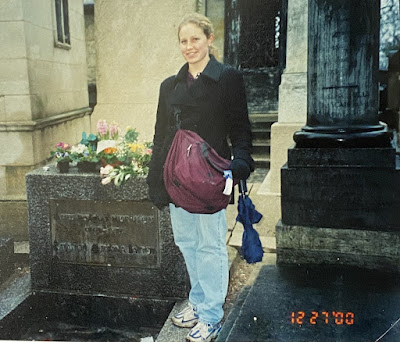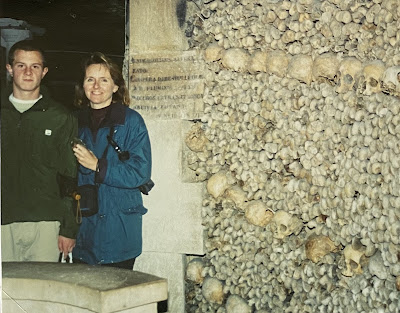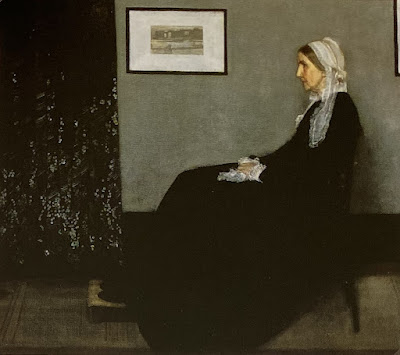December 27-28, 2000
Our next stop was Père-Lachaise Cemetery, the largest cemetery in the city with over one million bodies buried there and countless more cremated remains in the columbarium. It is the most visited cemetery in the world, getting about 3.5 million visitors each year. Established in 1804, it is named for the confessor to Louis XIV, Père François de la Chaise, who lived in a Jesuit house that once stood where the cemetery chapel is now.
Covering 110 acres, Père-Lachaise is the final resting spot for many famous people, including the Polish composer Frédéric Chopin, the French novelist Marcel Proust, medieval lovers and letter-writers Abelard and Heloise, the American singer-songwriter Jim Morrison, the French actress Sarah Bernhardt, the French novelist Honoré de Balzac, the French Romantic artist Eugene Delacroix, the Irish playwright Oscar Wilde, the composer Georges Bizet, and the French playwright Molière, to name just a few.
The rule is that you can only be buried in a Paris cemetery if you die in Paris (as in the cases of Jim Morrison and Oscar Wilde) or if you have lived there. Also, these days you lease a plot, and if the lease isn't renewed, the remains are dug up and cremated, and the plot gets a new resident who can pay rent.
We visited the cemetery on an appropriately gloomy day, a day when it looked like the set for a horror movie.
These next three photos are of no one's graves in particular, just "picturesque" burial spots.
This one is an interesting mix of old and new.
Jim Morrison, lead singer and songwriter for the rock group the Doors, died in Paris at age 27 under somewhat suspicious circumstances. The first time we walked past his grave there was a man standing next to the stone swaying and singing softly what we can only assume was one of the Doors' hits. A few others were reverently standing by. We decided to come back when it was less crowded.
We went around the corner and happened upon the grave of Frédéric Chopin, one of the leading composers of the early 19th century. He also died young--age 39. An interesting story is that after his death, his physician removed his heart and sent it back to Chopin's native Poland. It can be found in the
Holy Cross Church in Warsaw, still pickled in alcohol in the glass bottle and interred in a marble column.
Anyway, we eventually got a picture of our daughter in front of Morrison's grave, and we noted that while his stone was covered with flowers, Chopin's was bare but for one red bloom tucked in the iron grille surrounding his tomb.
Our older son had been reading
A Tale of Two Cities by Charles Dickens for his English class, so we made an effort to stop at the
Place de la Bastille, a monument marking the site where a fortress called the Bastille once stood. At the beginning of Dickens's novel, one of the main characters is released after having been imprisoned in the Bastille for 18 years, and later in the story French insurgents storm the Bastille, a symbol of royal authority and abuse, during the French Revolution.
Of course, it would be wrong to go to Paris and not go to the world's most famous art venue, the
Musée du Louvre. Originally a royal residence was on this site, but it was demolished and rebuilt and then extended over the centuries until it reached its present size and shape in the 18th century at about the time Louis XIV established his royal palace in Versailles. In 1980 it was expanded once again and the existing space was renovated, including the addition of a new pyramid-shaped entrance designed by Chinese-American architect I. M. Pei (who also designed the JFK Library in Boston, among other buildings).
We were still travel novices, and adding two teenaged boys and thousands of other tourists to the mix made for a less than perfect Louvre experience. Still, I managed to take more pictures (and buy more postcards) here than many other places on our trip.
We all found our favorite pieces.
Left: The statue of Muse Melpomene, 50 BC
Right: Venus de Milo, 160 to 110 BC
I have this cartoon pasted in our scrapbook:
This somewhat odd sculpture is a representation of the Tiber River with Romulus and Remus, 1st-2nd century:
Compare my photo of Winged Victory (2nd century BC) to the postcard I bought. Which one is better? The mom in me says mine because those are my kids standing in front.
And there she is, Mona Lisa herself. As I recall, the room was packed with people straining to get a look at what might be the most famous painting in the world. I was surprised by how small it is--just 21" x 30".
I love this photo from
Wikipedia, taken in 2015 and showing pretty much what was our experience.
These two sculptures of slaves by Michelangelo were Bob's favorites.
In contrast, one of my favorites was Botticelli's
Virgin and Child.
The museum is worth visiting just for the magnificent interior architecture.
But alas, after about 20 minutes, this is what the male segment of our family looked like. One of them (who shall remain nameless) said, "When will this be OVER?" This is the LOUVRE, guys! What's wrong with you???
The next morning we got up early to make our way from our hotel in Versailles to the Charles de Gaulle Airport. We left plenty of time to get there, but we hit a huge snag. There was a major accident on the freeway, and after sitting in a parking lot of traffic, we were eventually directed off the freeway to detour, and then we couldn't find our way back to the freeway. Remember, this was pre-cell phone days, even pre-GPS, and we didn't have a map. We wandered around for quite a while and then miraculously found our way back onto the freeway and to the airport. The stopped traffic and then the detour had eaten up almost two hours, and we were dangerously late.
Our daughter, who had been in France for six months, was on a different flight than we were, and it left from a different terminal. Her plane was leaving first, so Bob pulled our rental van up to the curb and I ran in with her. The desk person told her she was too late to make her flight. She started to cry (she SO wanted to go home), and the attendant gave in, checked her bags, and told her to run to the gate--they would hold it for her.
One down, four of us to go. We sped to our terminal, and Bob pulled up to the curb. As we were getting out of the van, in my rush I slammed the car door on my oldest son's fingers. He, of course, crumpled to the ground in pain. Bob was stressed over getting the car back, so I gathered up my son, and we left the van at the curb and went in, checked our bags, and got our boarding passes. Bob headed back out to return the van to the off-site Sixt Car Rental agency. The boys and I found a little corner in the airport and had a prayer. We prayed for my son's throbbing fingers and for their dad driving away from us. Then we got in line, went through immigration, and waited to board. Not much later, we got on the plane, took our seats, and waited and waited some more. No Bob. The flight attendant came by several times asking where my husband was. "I don't know!" I said over and over, near tears.
Meanwhile, Bob had taken a wrong turn on the way to the car rental and was on a divided highway leading away from the airport and away from the city. There was nowhere for him to turn around for about 20 minutes. He knew time was running out, and by the time he got back to the airport and to the right road that led to the car rental return, there was no more time.
So he did an unbelievably crazy thing. He parked the car at the curb in front of the terminal, locked the doors, and ran inside, stopping at the airline desk to give THEM the keys to the van. Someone spoke English, and he explained, as quickly as he could, his situation. He told them he would call the car rental company from the phone on the plane (they used to have phones in the back of the seats) and tell them to come get the keys and take the car away.
Then Bob started running for the gate. As he was running, he heard, "Roh-bert Can-none, Roh-bert Can-none" over the intercom, and something about the gate closing. When he got to immigration, he pushed through about fifty people to the front of the line. (This was pre-9/11 and pre-ultra security.) They must have recognized the desperation on his face, and they let him through.
Back on the plane, I was trying hard not to cry. Had Bob gotten in an accident? Where was he? We were on our way across the ocean, and I wouldn't know what had happened to him for hours. Also, he had the car keys. What would I do when I got to the airport? I had two kids with me and one another one on another plane coming in around the same time we were, and I couldn't just hop on a return flight to Paris.
Then . . . the flight attendant signaled to me that something was happening. Bob, a hot, sweaty, heart-pounding mess, came pushing down the aisle. I've never felt so relieved before or since. People around us who had heard the flight attendant's questions clapped and smiled as Bob fell into the seat next to me. The flight attendants closed the door and the access ramp pulled away. Minutes later we were taking off.
It took Bob about 15 minutes to get control of his breathing, and by then we were far enough into the flight that he could make a phone call to the car rental. He told them what he had done, and they replied, "You can't do that."
"But I already did!" he said.
"No, you CAN'T DO THAT," they repeated more than once. Thankfully, there was nothing we could do at that point.
To say they were unhappy is an understatement.
We waiting nervously for months for the bill from Sixt for the trouble Bob had caused, or for a ticket from CDG Airport for illegal parking. Nothing ever came. It took us years until we dared rent a car overseas from Sixt again. It makes a great story now, but man, it was incredibly stressful when we were in the middle of it. We hope we never have another ending to a trip like that.
Overall, this was an incredible trip to Germany, Austria, and France. It was the first time for me on the European mainland, and the only time we have been overseas with all three of our kids. The time with my mom in Germany was priceless. We lost her nine years later. Our experience sharing in our daughter's study abroad experiences was also a treasure. It was a stretch for us financially in those days, but worth every penny.























































